
Types Of Crops In Agriculture: Why And How To Classify
A variety of crop type classifications are practical in agriculture. Foremost, there’s a list of different types of crops depending on their commercial purposes. Plants can also be classified based on their life cycles, making it easier for farmers to schedule their planting and harvesting activities. A new group of genetically modified organisms has recently taken an essential place among types of agricultural crops, helping to make food more accessible while also having some negative environmental impacts.
Farmers should always consider the characteristics of various crop types when choosing which ones to plant and planning their agricultural activities. Modern technology will be especially beneficial for large-scale plant type classification and management.
Types Of Crops Based On Their Uses
Rather than being a precise scientific classification of plants, this list of crop types describes their uses and economic value. Based on the intended use, there are 6 types of crops: food, forage, fiber, oil, ornamental, and industrial.
Food Crops
Food plants were historically the first to be harvested and cultivated. They are grown for human consumption. Food plants, particularly grains, are strategically important. At the same time, farmers should keep in mind that while industrial food plant cultivation has many benefits, it can also have negative environmental consequences, such as greenhouse gas (GHG) emissions.
The following are the types of food crops.
Cereals: wheat, rice, barley, millet, oats, rye, sorghum, and others. Grains are a rich source of starch, protein, dietary fiber, and nutrients and are an integral part of the daily diet. In particular, maize, rice, and wheat provide the most calories and protein consumed in developing countries.
Seeds include several types of field crops, such as cereals, nuts, legumes, and some spices. Seeds are high in fiber, fats, vitamins, minerals, and antioxidants.
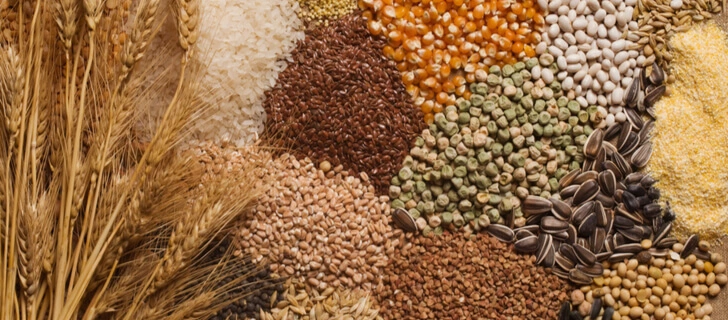
Fruits: apples and pears, citrus, stone fruits, tropical and exotic fruits, berries, and other types. Fruits contain a lot of dietary fiber, vitamins, minerals, and antioxidants, such as flavonoids, which promote good health.
Vegetables are high in water content and low in calories. They are also rich in dietary fiber, antioxidants, minerals, and vitamins (especially A and C). There are several types of vegetable crops:
- root vegetables: beets, carrots, sweet potatoes, turnips;
- tubers: potatoes, yams;
- stem vegetables: asparagus, kohlrabi, celery;
- leafy green: lettuce, spinach, silverbeet;
- allium or bulb vegetables: garlic, leeks, onions, shallots;
- head or flower vegetables: artichokes, cabbage, cauliflower;
- cucumber family vegetables: pumpkin, cucumber, zucchini.
Spices fall into three types: the spices themselves (pepper, ginger), spice seeds, and herbs. Spices are used sparingly to enhance food flavor and aroma. They contain essential oils and alkaloids that aid appetite and digestion.
Forage Crops
Forage, aka feed, plants contain nutrients that animals require for development. They are grown for livestock consumption and are essential in pasture management. Some of the most crucial types of forage crops are sorghum, alfalfa, barley, oats, millet, soybeans, wheat, and maize.
Forage is classified into two types based on how it is processed:
- hay is forage that has been cut, dried in the field, and stored;
- silage is produced by harvesting the plants and storing them in conditions that allow them to be split (fermented) into acids. Types of silage crops include perennial and annual grasses and legumes.
With increased global demand for meat, forage production has skyrocketed. Higher forage production has altered the agricultural landscape, causing massive deforestation to create grazing pastures for livestock.
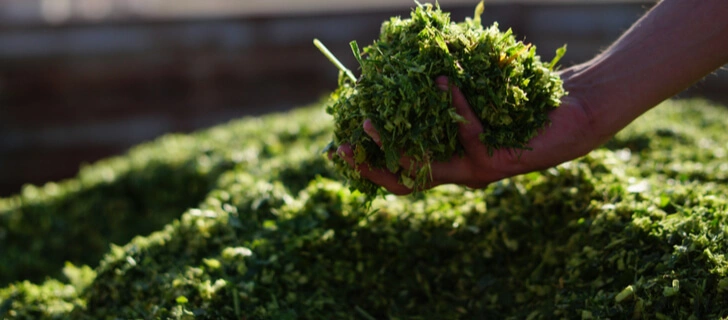
Fiber Crops
Plants grown to produce fiber for textiles, cordage, filling, and paper are known as a fiber type of crops. The well-known fiber plants are cotton, hemp, jute, kenaf, and flax. Some of them have a good prospect as agricultural biomass with the potential of being converted to ethanol.
Oil Crops
Thanks to technological advances in agruculture over the last century, plants can be processed and broken down into their primary components, including oil. Today, the oil type of crops is the second most important determinant of the agricultural economy (after cereals) and is the third largest user of farmland .
The essential plants of this type are soybeans, sunflower seeds, rapeseed, canola, and peanuts. They are high in oils, dietary fibers, proteins, minerals, and vitamins. Apart from producing oil for human consumption, this type of plants is used in various industries, including soaps, paints, machinery lubricants, fuel, and many more.
Oil plants also supply the raw materials for biodiesel production. Soybean, rapeseed, sunflower, camelina, and palm are typical biodiesel sources. Due to palm trees’ high yield potential, the palm oil cultivation industry is constantly expanding.
Manage your fields with high-resolution satellite images for the most accurate and timely changes detection!EOSDA Crop Monitoring
Ornamental Crops
Plants grown for decorative purposes in parks, gardens, and landscaping design projects are related to the ornamental type. Ivy, oleander, holly, tulips, and azaleas are common decorative plants.
Industrial Crops
They are also referred to as cash or commercial type of crops. Growing tobacco, cotton, jute, sugarcane, sugarbeet, coffee, tea, coconut, or soybeans generates high incomes for farmers worldwide.
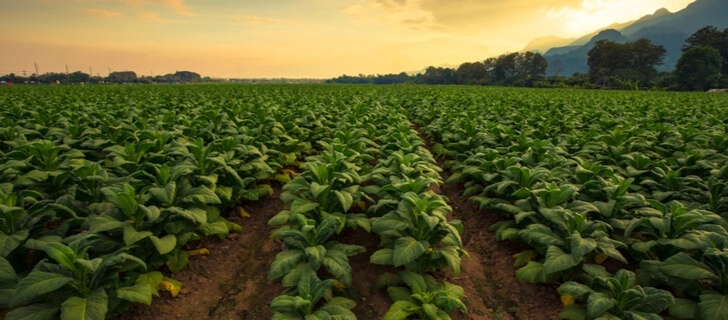
As you may have noticed, the same plant can belong to multiple types in the classification by use. For example, wheat and oats can be food or forage types. Sugarcane provides both edible sugar and alcohol for bioethanol production. There are, of course, exceptions. Let’s say that most decorative flowers are as poisonous as they are beautiful.
Types Of Crops By Life Cycle
Each crop goes through a series of stages of plant growth, from germination to seed production. The total duration of all these stages, namely the life cycle, varies between plants. So, according to their life cycles, what are these types of crops? There are 3 types: annual, biennial, and perennial, which we’ll look into further.
Annual Plants
Annual or seasonal plants have a one-year life cycle. Because only dormant seeds can pass from one generation to another, crops of the annual type must be replanted each season. Tomatoes, radishes, eggplant, peas, beans, squash, lettuce, mustard, sunflowers, and grains are examples of annual plants.
Biennial Plants
Biennials are flowering plants with a biological life cycle of two years (two growing seasons). During the first year, the plant grows vegetative organs such as leaves, stems, and roots. Then, the plant enters a resting phase and overwinters underground during the cold season. Stem elongation, flower and seed development, and ripening occur during the second growing season, after which the plant dies. Biennial crop type includes carrots, beets, turnips, onions, cabbage, parsley, and coriander.
Perennial Plants
Perennials are plants that can live for more than two growing seasons. This type usually grows new herbaceous part from the previously existing root system from season to season. Perennials include trees and shrubs such as pears, apples, almonds, peaches, walnuts, and hazelnuts. Some herbaceous flowering plants and ground covers also belong to the perennial type.

Genetically Modified Organisms
Previously, breeders selected the best specimens to give plants desired characteristics, such as higher productivity or resistance to certain types of diseases. Thanks to genetic engineering, we can obtain such features much more quickly and with greater certainty. As a result, a distinct type of crops emerged: genetically modified organisms (GMOs) — plants that have had their genetic material artificially modified.
Farmers can now purchase GM seeds to grow plants resistant to different types of irritants: diseases, extreme temperatures, chemicals, and others. In this way, farmers can significantly reduce costs and increase crop yields. The variety of applications for different types of genetically engineered crops is astounding:
- nutritional improvement: increased vitamin content and healthier fatty acid profiles;
- stress tolerance: resistance to extreme temperatures, drought, or soil salinization;
- disease resistance: enhanced resistance to various types of plant pathogens, such as bacteria, viruses, and fungi;
- biofuels: improved ethanol conversion through modified plant cell wall composition;
- phytoremediation: plants’ ability to extract pollutants from the soil.
Despite the numerous benefits of GMOs, the spread of genetic modification can drastically reduce biodiversity. Besides that, as GM plants become pesticide resistant, the use of chemicals increases significantly. Therefore, while organic farming is typically more expensive, it has numerous benefits in terms of sustainability.
How To Classify And Manage Different Types Of Crops With Satellite Technology
When deciding which types of crops to plant, historical data about the region and the needs of each plant must be considered. Later, growers have to use various cultivation and field management practices to maximize yields. Satellite technologies, radar, and multispectral images help farmers with all of these tasks. Using satellite imagery, you can analyze large areas and obtain accurate information about the field’s historical and current vegetation.
Irrigation Management
Water use differs by crop type. When looking at historical yield data, you will notice that some types of plants yield more than others in areas with certain moisture levels. For example, water is essential for successful alfalfa cultivation. The same goes for rice, soybeans, wheat, sugarcane, and cotton.
If the climate has dry spells, farmers should consider a precision irrigation system. This system must provide plants with adequate moisture at all stages of their development while consuming minimal resources. Historical weather data from EOSDA Crop Monitoring allows you to see climate trends in a specific field or region, compare precipitation and soil moisture to plant needs, and efficiently prepare your field for the next growing season.
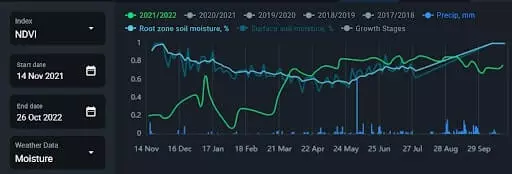
With a weather forecast Using reliable weather data in agriculture, farmers can save money on irrigation by predicting rain or protect their fields in advance by anticipating potentially damaging natural phenomena like hail or frost.

Crop Rotation Control
Specific plant sequences are known to increase yield. Many types of crops tend to develop faster after growing chickpeas, soybeans, and beans, for example, because legumes act as nitrogen fertilizer by converting atmospheric nitrogen to a plant-available form and releasing it into the ground. These observations resulted in the development of several alternative cropping systems, including monoculture, crop rotation, and intercropping.
Any major player in the agricultural sector (whether a farming cooperative, an agro-consultant, or a bank that provides agro loans) can keep records of crop rotation and analyze its productivity on the precision agriculture platform. The field activity log makes it simple to plan your cropping activities, collect and organize data on the types of plants grown in previous seasons, sowing and harvesting dates, and more. You can also create a productivity map for a specific field over several years. Low productivity may indicate an incorrect crop sequence, which you should reconsider.
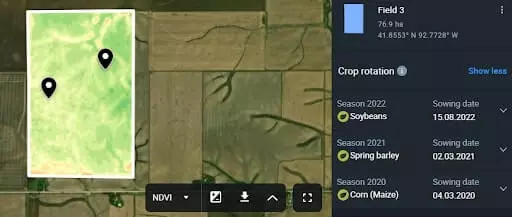
Crop Type Classification
EOSDA also provides a variety of tailored solutions for large agricultural enterprises. One is crop classification, which allows for building a crop type map in a given region. This technology enables:
- agricultural cooperatives, banks, and other agricultural companies to conduct large-scale inventories and yield assessments;
- insurance companies to validate compensation requests with more transparent and accurate crop type classification data;
- agricultural consultants to keep track of crop rotation in separate areas;
- input suppliers to more easily select the resources required for efficient land use management with precise crop type classification.

More applications for satellite data to define and manage crop types include vegetation monitoring using NDVI, NDRE, ReCI, and MSAVI vegetation indices, organizing field scouting and saving scouting reports, planning field activities, and much more. In 2023, EOSDA launched its own multi-purpose satellite into orbit to provide growers, agriculture insurers and banks, input suppliers, and other stakeholders with even more detailed analytics about their fields. Contact our sales team at sales@eosda.com for more information on these and other EOSDA offerings.
About the author:
Vasyl Cherlinka is a Doctor of Biosciences specializing in pedology (soil science), with 30 years of experience in the field. He attended the engineering college in Ukraine and received his degree in agrochemistry, agronomy and soil science in the Chernivtsi National University. Since 2018, Dr. Cherlinka has been advising EOSDA on problems in soil science, agronomy, and agrochemistry.
Recent articles

Transition Guide From Sentinel Hub EO Browser To EOSDA LandViewer
Need an EO Browser alternative that’s just as familiar but more flexible? EOSDA LandViewer offers free recent imagery, a vast satellite data archive, and advanced analytical tools.
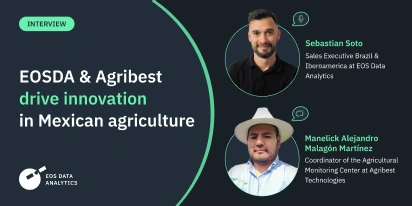
EOSDA & Agribest: Driving Agtech Growth In Mexico
In this insightful interview, Agribest shares how its collaboration with EOSDA is shaping Mexico’s agricultural future, with a focus on profitability, sustainability, and technology.
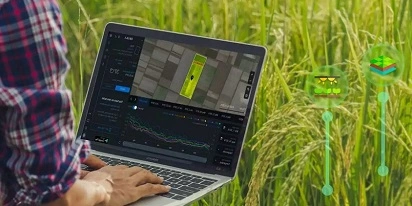
Top Ready-Made Agriculture Tools & Softwares for 2025
Agriculture softwares are silent partners in the field, working tirelessly behind the scenes to support farmers with insights and precision to cultivate sustainable agricultural ecosystems.